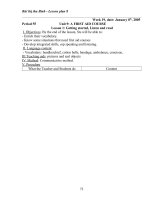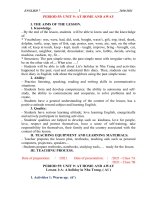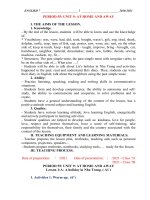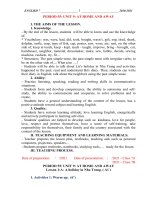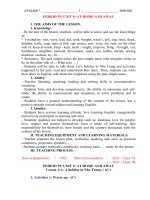GIÁO ÁN TIẾNG ANH 8 HK2 CV 5512
Bạn đang xem bản rút gọn của tài liệu. Xem và tải ngay bản đầy đủ của tài liệu tại đây (1.4 MB, 188 trang )
Period 55
UNIT 7: POLLUTION
Lesson 1: Getting started
I. OBJECTIVES: By the end of the lesson, ss will be able to:
- Listen and read the dialogue about a factory in Mi's home village for details and then
do some related exercises.
- Use lexical items related to the topic ‘Pollution’ to talk about types of pollution
1. Knowledge:
a. Vocabulary: Aquatic; Dump; Poison; Sneeze; Illustrate
b. Grammar: Conditional sentences.
2. Competence development: Teamwork and independent working, pair work,
linguistic competence, cooperative learning and communicative competence
3. Qualities: Ss will be more responsible for protecting environment.
II. TEACHING AIDS
1. Materials: Textbooks, plan
2. Equipment: computer accessed to the Internet, projector, loudspeaker
III. PROCEDURE
1. Checking: During the lesson
2. New lesson:
Teacher’s and students’ activities
1. Warm up.
The main contents
Aim: To attract Ss’s attention to the lesson and to lead in the new lesson
Content: do the following tasks and practise skills
Organization
Expected outcome
- Ss have a small talk about pollution.
Presentation and discuss
- T gives comments.
- T: Introduce the lesson about the new
lesson.
2. Presentation
Aim: Help students listen, read and do some exercises about the conversation
Content: do the following tasks and practise skills
1
Organization
Expected outcome
- T: Ask some questions about picture.
I- Listen and read
+ Where are Mi and Nick?
+ Where are they doing?
+ What are they talking about?
- Ss: Answer the questions
- T: Play the recording.
- Ss: Listen to the tape (twice) and then check
the guessing.
New words:
- T: Give some new words
- Aquatic: dưới nước
- Ss: Read in chorus and individually.
- Dump: đổ xuống
And copy all the words.
- Poison: chất độc hại
- Sneeze: hắt hơi
- Illustrate: minh họa
- T asks the Ss to read the conversation again
a. Find the word/ phrase that means.
and do exercise a.
- Ss do it.
- T asks them to compare their answers with
their friends.
- T asks them to read the answers.
- Some Ss read, the others give comments.
- T checks and corrects.
- SS take notes.
1- dead 2- aquatic 3- dump 4- poison
5- polluted 6- to come up with
b. Answer the questions
- T asks the Ss to read the conversation again
and answer the questions.
- Ss do it in pairs.
- T asks them to compare their answers with
1. They are in Mi’s home village.
their friends.
2. It’s almost black.
- Ss do it.
3. She’s surprised because she sees the
2
- T asks them to read the answers.
fish are dead.
- Some Ss read, the others give comments.
4. It’s dumping poison into the lake.
- T checks and corrects.
- Ss take notes.
- T asks the Ss to read the conversation again
c. True(T) fale (F) or no
and tick True (T)/ false (F) or no information
information(NI).
(NI).
1 - F ( It’s polluted by the factory)
- Ss do it in groups of 4.
2-T
- T asks them to compare their answers with
3 - NI
their friends.
4-T
- Ss do it.
5-T
- T asks them to read the answers.
- Some Ss read, the others give comments.
- T checks and corrects.
- Ss take notes.
3. Practice
Aim: Ss can use the words related to the topic “pollution”
Content: do the following tasks and practise skills
Organization
Expected outcome
- T asks the Ss to do task 2.
2. There are different types of pollution.
- T asks them to compare their answers
with their fiends.
A. radioactive pollution
- T asks some Ss to read their answers.
B. noise pollution
- Some Ss read, the others give the
C. visual pollution
comment.
D. thermal pollution
- T checks and corrects.
E. water pollution
F. land/ soil pollutio
G. light pollution
H. air pollution
- T asks Ss to do task 3.
- T asks them to compare their answers
3. Complete the sentences
3
with their fiends.
1. thermal pollution
- Ss do it.
2. Air pollution
- T asks some Ss to read their answers.
3. radioactive pollution
- Some Ss read, the others give the
4. light pollution
comment.
5. Water pollution
- T checks and corrects.
6. Land pollution / Soil pollution
7. Noise pollution
8. visual pollution
4. Further practice.
Aim: Complete the correct adjectives to describe some leisure activities
Content: do the following tasks and practise skills
Organization
Expected outcome
- T asks Ss to work in groups to talk about 4. Work in groups.
pollution in their neighborhood.
- T asks them to present in front of the
class.
- Ss do it.
3. Guides for homework
- Learn new words/ workbook: B1, 2, 3
- Prepare : A closer look 1
4
Period 56
UNIT 7: POLLUTION
Lesson 2: A closer look 1
I. OBJECTIVES: By the end of the lesson, Ss will be able to:
- Use words and phrases showing cause/effect relationships to describe the causes and
effects of pollution.
- Pronounce the words ending in “ic” and “al” correctly in isolation and in context.
1. Knowledge:
a. Vocabulary: poison, contaminate, pollutant, polluted, death, damaged
b. Grammar: Cause and effect
c. Pronunciation: “ic” and “al”
2. Competences: Teamwork and independent working, pair work, linguistic
competence, cooperative learning and communicative competence
3. Qualities: Ss will be more responsible for protecting environment.
II. TEACHING AIDS
1. Materials: Textbooks, plan
2. Equipment: computer accessed to the Internet, projector, loudspeaker
III. PROCEDURE
1. Checking: Write the new words and types of pollution
2. New lesson:
Teacher’s and students’ activities
The main contents
1. Warm up.
Aim: To attract Ss’ attention to the lesson and to lead in the new lesson
Content: do the following tasks and practise skills
Organization
Expected outcome
Presentation and discuss
Ss have a small talk about pollution in
their neighborhood.
2. Presentation.
Aim: Help students use words and phrases showing cause/effect relationships to
5
describe the causes and effects of pollution.
Content: do the following tasks and practise skills
Organization
Expected outcome
T asks the Ss to do task 1.
I. Vocabulary
Ss do it.
1. Complete the table.
T asks them to compare their answers
with their fiends.
Ss do it.
T asks some Ss to read their answers.
1. poison
Some Ss read, the others give the
2. contaminate
comment.
3. pollutant
T checks and corrects.
4. polluted
5. death
6. damaged
T asks the Ss to do task 2.
Ss do it.
2. Complete the sentences.
T asks them to compare their answers
with their fiends.
Ss do it.
T asks some Ss to read their answers.
Some Ss read, the others give the
comment.
1. poisonous 2. pollutants 3. dead
T checks and corrects.
4. contaminated 5.contaminated
6. pollute
T introduces structure.
Structure:
Ss take notes.
Because/ since + clause
Due to/ because of + Sth
So+ clause
To cause sth/ to lead to sth/ to result in sth
To make sb/ sth/ do sth
3. Practice
Aim: Ss can use words and phrases to do exercise and Pronounce the words ending in
“ic” and “al” correctly in isolation and in context.
6
Content: do the following tasks and practise skills
Organization
Expected outcome
T asks the Ss to do task 3.
3a. Write C for cause and E for effect
Ss do it.
T asks them to compare their answers
with their fiends.
Ss do it.
T asks some Ss to read their answers.
Some Ss read, the others give the
1. C-E 2C-E 3E-C 4E-C
comment.
T checks and corrects.
3b Combine sentences.
T asks the Ss to do task 3b.
Ss do it.
T asks them to compare their answers
with their fiends.
1. Oil spills from ships in the oceans and rivers
Ss do it.
lead to the death of many aquatic animals and
T asks some Ss to read their answers.
plants.
Some Ss read, the others give the
2. Households dump waste into the river so it is
comment.
polluted.
T checks and corrects.
3. Since the parents were exposed to radiation,
their children have birth defects.
T introduces stress in words ending in
4. We can't see the stars at night due to the light
–ic and - al.
pollution.
Ss listen and take notes.
II. Pronunciation
7
T asks the Ss to listen and mark the
stress in each words.
Ss do it.
T asks some Ss to read their answers.
Some Ss read.
6. Listen and mark the stress in each words,
T checks and corrects.
then repeat again.
1. ar'tistic
2. ath'letic
3. his'toric
T asks the Ss to do task 7.
4. his'torical
Ss do it.
5. 'logical
T asks them to read their answers.
6. 'physical
Some Ss read.
7. he'rotic
T checks and corrects.
8. po'etic
9. bo'tanic
10. bo'tanical
7. Underline the words ending in –ic and circle
the words ending in – al in the following
sentences.
4. Further practice.
Aim: Ss can talk to show cause/ effect relationship.
Content: do the following tasks and practise skills
Organization
Expected outcome
T asks the Ss to work in groups to
Work in group
look at the pictures and give as
People cough because they breathe in the fumes
many sentences as possible to show
from cars.
cause/ effect relationship.
The fumes from cars make people cough.
Ss do it.
8
T asks some Ss to read their
answers.
Some Ss read.
T checks and corrects.
3. Guides for homework.
- Do exercise 3,4 in workbook.
- Talk about pollution in their neighborhood.
- Prepare: A closer look 2
Period 57
UNIT 7: POLLUTION
Lesson 3: A closer look 2
I. OBJECTIVES: By the end of the lesson, Ss will be able to:
- Use conditional sentences type 1 and type 2 correctly and appropriately to describe
pollution.
1. Knowledge:
a. Vocabulary: related to the topic: Pollution
b. Grammar: conditional sentences type 1 and type 2
2. Competences: Teamwork and independent working, pair work, linguistic
competence, cooperative learning and communicative competence
3. Qualities: Ss will be more responsible for protecting environment.
II. TEACHING AIDS
1. Materials: Textbooks, plan
2. Equipment: computer accessed to the Internet, projector
III. PROCEDURE
1. Checking: Talk about pollution in their neighborhood.
2. New lesson:
Teacher’ and students’ activities
The main contents
1. Warm up
Aim: To warm up the class and lead in the lesson
9
Content: do the following tasks and practise skills
Organization
Expected outcome
Ss talk about some types of pollution.
* Brainstorming:
POLLUTION
2. Presentation.
Aim: Help Ss review conditional type 1.
Content: do the following tasks and practise skills
Organization
Expected outcome
T asks the Ss to do task 1.
I. conditional type 1
Ss do it.
1. Put the verbs in brackets into the correct
T asks them to compare their answers
form
with their friends.
Ss do it.
T asks some Ss t read their answers.
1. recycle/will help
Some Ss read.
2. won’t dump/fines
T checks and corrects.
3. travel/will be
4. will save/don’t waste
T asks the Ss to do task 2.
5. use/will have
Ss do it.
2. Combibe sentences
T asks them to compare their answers
with their friends.
Ss do it.
T asks some Ss t read their answers.
Some Ss read.
T checks and corrects.
1. Students will be more aware of protecting the
environment if teachers teach environmental
issues at school.
10
2. When light pollution happens, animals will
change their behavior patterns.
3. The levels of radioactive pollution will
decrease if we switch from nuclear power to
renewable energy sources.
4. If the water temperature increases, some
aquatic creatures will be unable to reproduce.
5. People will get more diseases if the water is
contaminated.
3. Practice
Aim: Help Ss to know more about conditional type 2.
Content: do the following tasks and practise skills
Organization
Expected outcome
T introduces conditional type 2.
II. Conditional type 2.
Ss listen and take notes.
3. Match A with B
T asks the Ss to do task 3.
Ss do it.
T asks them to compare their answers
with their friends.
1-b, 2-c, 3-d, 4-e, 5-a
Ss do it.
T asks some Ss t read their answers.
4. Put the verd in the correct form
Some Ss read.
T checks and corrects.
11
T asks the Ss to do task 4.
Ss do it.
T asks them to compare their answers
1. were/would you (do) do
with their friends.
2.exercised/would be
Ss do it.
3.had/would build
T asks some Ss t read their answers.
4.tidied /wouldn’t be
Some Ss read.
5.was / were/would grow
T checks and corrects.
5. Complete the sentences
T asks the Ss to do task 5.
Ss do it.
1. If there weren’t so many billboards in our
T asks them to compare their answers
city, people could enjoy the view.
with their friends.
2.If there wasn’t so much light in the city at
Ss do it.
night, we could see the stars clearly / If there
T asks some Ss t read their answers.
weren’t so much light in the city at night, we
Some Ss read.
could see the stars clearly.
T checks and corrects.
4. Further practice
Aim: Ss can talk about real situation using conditional type 1 and type 2
Content: do the following tasks and practise skills
Organization
Expected outcome
T guides the Ss to do to give real
* Chain game.
situation using conditional type 1 and
Example:
type 2.
A: If each person plants a tree, there will be a
Ss do it.
lot of trees.
T corrects and remarks
B: If there are a lot of trees, the air will be
cleaner.
C: If the air is cleaner, fewer people will be ill.
12
3. Guides for homework
- Make sentences with conditional type 1 and type 2.
- Do the task in part Vocabulary & grammar in workbook.
- Prepare: Communication.
13
Period 58
UNIT 7: POLLUTION
Lesson 4: Communication
I. OBJECTIVES: By the end of the lesson, Ss will be able to:
- Talk about noise pollution
- Discus the way to prevent noise pollution.
1. Knowledge:
a. Vocabulary: Permanent; Earplug; Affect; Hearing loss; Blood pressure
b. Grammar: conditional sentences type 1 and type 2
2. Competences: Teamwork and independent working, pair work, linguistic
competence, cooperative learning and communicative competence
3. Qualities: Ss will be more responsible for protecting environment.
II. TEACHING AIDS
1. Materials: Textbooks, plan
2. Equipment: computer accessed to the Internet, projector, loudspeaker
III. PROCEDURE
1. Checking: During the lesson
2. New lesson:
Teacher’s and students’ activities
The main contents
1. Warm up
Aim: To warm up the class and lead in the lesson
Content: do the following tasks and practise skills
Organization
Expected outcome
- Ss talk about the effect of
Presentation and discuss
pollution.
- T gives comment about the talk.
2. Presentation
Aim: Ss can know some vocabulary words about noise pollution
Content: do the following tasks and practise skills
Organization
Expected outcome
- T presents the vocabulary
Extra vocabulary
- Ss read the vocabulary
Permanent: usually
14
Earplug: cái nút tai
Affect: ảnh hưởng
Hearing loss: mất thính lực
Blood pressure: huyết áp
3. Practice
Aim: Ss can understand and answer the questions
Content: do the following tasks and practise skills
Organization
Expected outcome
T asks the Ss to do task 1.
1. Answer the questions.
Ss do it.
T asks them to compare their answers
with their friends.
Ss do it.
T asks some Ss t read their answers.
Some Ss read.
T asks the Ss to do task 2.
2. Compare your answer with those of a
Ss do it.
classmate
T asks them to compare their answers
with their friends.
Ss do it.
T asks some Ss t read their answers.
Some Ss read.
T asks the Ss to do task 3.
Ss do it.
3. Listen and check your answer
T asks them to compare their answers
with their friends.
Ss do it.
T asks some Ss to read their answers.
Some Ss read.
T checks and corrects.
15
4. Further practice
Aim: Ss discuss the ways to prevent noise pollution.
Content: do the following tasks and practise skills
Organization
Expected outcome
T asks the Ss to discuss the ways to
4. Work in groups. Discuss other ways to
prevent noise pollution.
prevent noise pollution.
Ss do it in groups.
3. Guides for homework
- Learn new words by heart
- Do exercises in workbook: C. Speaking
- Prepare for the next lesson: Skills 1
16
Period 59
UNIT 7: POLLUTION
Lesson 5: Skills 1
I. OBJECTIVES: By the end of the lesson, Ss will be able to:
- Read for general and specific information about water pollution.
- Talk about the causes and effects of water pollution as well as ways to reduce it
1. Knowledge:
a. Vocabulary: about water pollution
b. Grammar: Review conditional type 1 and 2.
2. Competences: Teamwork and independent working, pair work, linguistic
competence, cooperative learning and communicative competence
3. Qualities: Ss will be more responsible for protecting environment.
II. TEACHING AIDS
1. Materials: Textbooks, plan
2. Equipment: computer accessed to the Internet, projector, loudspeaker
III. PROCEDURE
1. Checking: Write the new words
2. New lesson:
Teacher’s and students’
The main contents
activities
1. Warm up.
Aim: To warm up the class and lead in the lesson
Content: do the following tasks and practise skills
Organization
Expected outcome
Ss have small talk about the
1. Discuss: Cause and Effect of Noise pollution
cause and effect of noise
pollution.
2. Presentation.
Aim: Read the information about water pollution.
17
Content: do the following tasks and practise skills
Organization
Expected outcome
T gives students pictures and
I- READING
asks students to write stentences
1. Work in pairs. One of you look at pA and the
about picture.
other look at pB. Ask and answer the questions to
Ss do it.
find differences between your pictures.
T asks some Ss to read their
answers.
Some Ss read.
T checks and corrects.
2. Read the passage then answer the questions
T asks the Ss to do task 2.
Ss do it.
1. The second paragraph tells about the causes of
T asks them to compare their
water pollution.
answers with their friends.
2. The third paragraph tells about the effects of
Ss do it.
water pollution.
T asks some Ss to read their
3. It’s the water beneath the Earth’s surface.
answers.
4. They are industrial waste, sewage, pesticides, and
Some Ss read.
herbicides.
T checks and corrects.
5. They are pollutants from storm water and the
atmosphere.
6. They use herbicides to kill weeds.
3. Read the text again and complete the note.
1. If the drinking water is untreated, an outbreak
18
T asks the Ss to do task 3.
of cholera may happen.
Ss do it.
2. People drinking contaminated water may die.
T asks them to compare their
3. Fish, crabs or birds, may also die because
answers with their friends.
of polluted water.
Ss do it.
4. Other animals may become ill if they eat
T asks some Ss to read their
the dead animals.
answers.
5. Her bicides kill both weeds and aquatic plants.
Some Ss read.
T checks and corrects.
3. Practice.
Aim: Talk about the causes and effects of water pollution as well as ways to reduce it
Content: do the following tasks and practise skills
Organization
Expected outcome
T asks the Ss to do task 4.
II. Speaking
Ss do it in groups.
T asks them to compare their
4. Work in groups and discuss the solution to
answers with their friends.
water pollution.
Ss do it.
T asks some Ss to read their
answers.
Some Ss read.
T checks and corrects.
5. Complete the diagram of water pollution.
T asks the Ss to do task 5.
Water pollution: Definition:
Ss do it in groups.
EFFECTS
T asks them to compare their
Humans:
answers with their friends.
- Animals:
Ss do it.
- Plants:
T asks some Ss to read their
CAUSES
answers.
- Point source pollutants:
Some Ss read.
- Non-point source pollutants:
T checks and corrects.
SOLUTIONS
19
4. Further practice
Aim: Ss can talk about protecting the environment
Content: do the following tasks and practise skills
Organization
Expected outcome
T asks Ss to talk about
Eg: Hello, I am going to tell you about protecting
protecting the environment
the environment
Ss talk about protecting the
environment
T corrects and remarks
3. Guides for homework.
- Do exercises in Workbook: Part: Reading.
- Prepare new lesson: Skills 2
20
Period 60
UNIT 7: POLLUTION
Lesson 6: Skills 2
I. OBJECTIVES: By the end of the lesson, Ss will be able to:
- Listen for specific information about thermal pollution.
- Write about causes and effects of one pollution type.
1. Knowledge:
a. Vocabulary: about pollution
b. Grammar: Review conditional type 1 and 2.
2. Competences: Teamwork and independent working, pair work, linguistic
competence, cooperative learning and communicative competence
3. Qualities: Ss will be more responsible for protecting environment.
II. TEACHING AIDS
1. Materials: Textbooks, plan
2. Equipment: computer accessed to the Internet, projector, loudspeaker
III. PROCEDURE
1. Checking: Write the new words
2. New lesson:
Teacher’s and students’ activities
1. Warm- up:
Content
Aim: To help Ss to pay attention in the lesson.
Content: do the following tasks and practise skills
Organization
Expected outcome
Presentation and discuss
T asks some questions about the cause and
effect of noise pollution and how to
protect the environment.
Ss answer the questions about the cause
and effect of noise pollution and how to
21
protect the environment.
T gives comment
T introduces the lesson
2. Presentation
Aim: Ss can describe what you see in the pictures and talk about relationship between
them
Content: do the following tasks and practise skills
Organization
T asks the Ss to talk about water pollution
Expected outcome
1. Describe what you see in the pictures
and talk about relationship between
Ss do it.
them
- The first picture shows an algal bloom in
coastal seawater.
- The second picture shows the cooling
towers from a power station.
- They are both related to thermal
pollution.
3. Practice
Aim: Help Ss listen for specific information about thermal pollution.
Content: do the following tasks and practise skills
Organization
Expected outcome
T asks the Ss to listen twice.
I. Listening
Ss listen.
2. Listen and complete the diagram.
T asks them to listen and complete the
diagram.
Ss do it.
22
T asks them to compare their answers with
their friends.
Ss do it.
T asks some Ss to read their answers.
Some Ss read.
1. hotter
T checks and corrects.
2.cooler
3. cool
4. warm rivers
5. warmer water
6. fish pollution
7. harmful
8. color
9. poison
10. cool down.
II. Writing
T asks the Ss to discuss in pairs.
3. Work in pairs discuss the cause and
Ss do it.
effect.
- Water pollution:
- Definition:
- Causes
- Effects:
3. Practice
Aim: Help Ss write about causes and effects of one pollution type.
Content: do the following tasks and practise skills
Organization
Expected outcome
T asks the Ss to write about the cause and
* Write about the cause and effect.
effect.
T: make one example:
23
Ss do it.
There are many ways to lead to polluted
water.
Firstly, polluted water comes from
companies
T asks them to compare their answers with
* Read each other’s work.
their friends.
Ss do it.
3. Guides for homework.
- Do exercise Part: Speaking in workbook.
- Prepare for: Looking back and project.
24
Period 61
UNIT 7: POLLUTION
Lesson 7: Looking back- Project
I. OBJECTIVES: By the end of the lesson, Ss will be able to:
- Review all the knowledge they have learnt.
1. Knowledge:
a. Vocabulary: related to pollution
b. Grammar: Review conditional type 1 and 2.
2. Competences: Teamwork and independent working, pair work, linguistic
competence, cooperative learning and communicative competence
3. Qualities: Ss will be more responsible for protecting environment.
II. TEACHING AIDS
1. Materials: Textbooks, plan, extra- board, studying- cards
2. Equipment: computer accessed to the Internet, projector
III. PROCEDURE
1. Checking: During the lesson
2. New lesson:
Teacher’s and students’ activities
1. Warm- up:
Content
Aim: To help Ss to pay attention in the lesson.
Content: do the following tasks and practise skills
Organization
Expected outcome
T asks the Ss to talk about some types of Presentation and discuss
pollution
Ss do it.
2. Vocabulary
Aim: help Ss review vocabulary related to leisure activities.
Content: do the following tasks and practise skills
Organization
Expected outcome
T asks the Ss to do exercise 1.
I. Vocabulary
25
